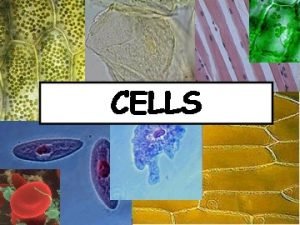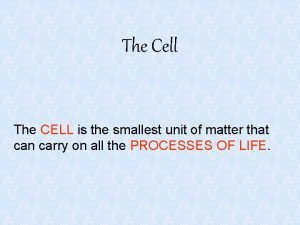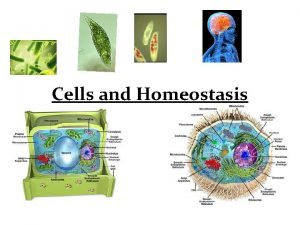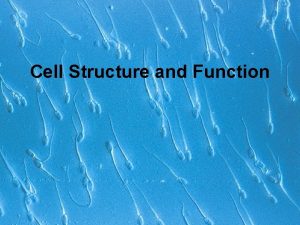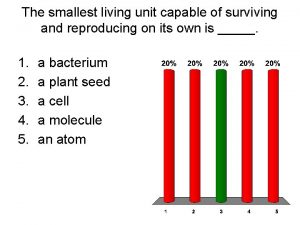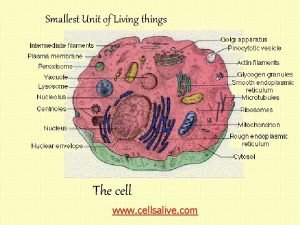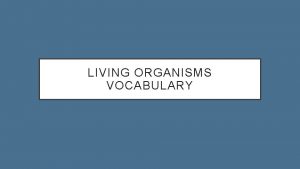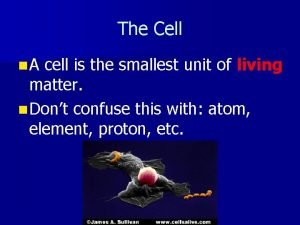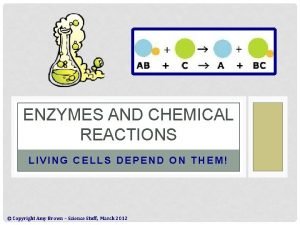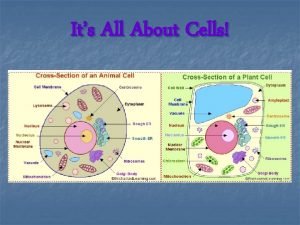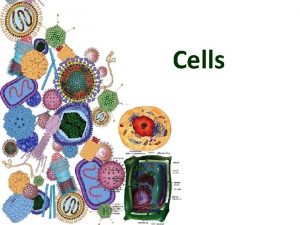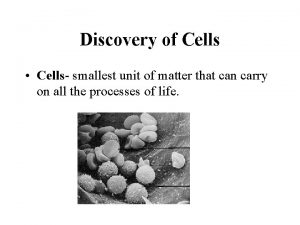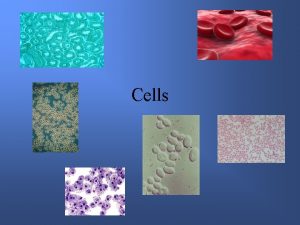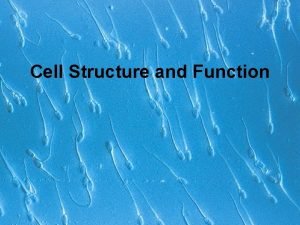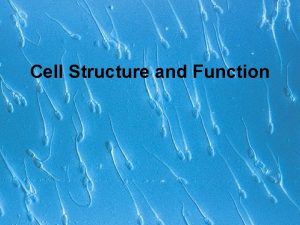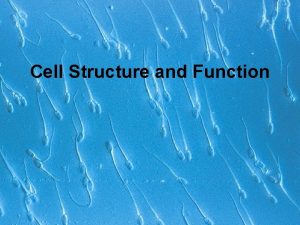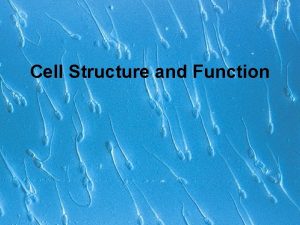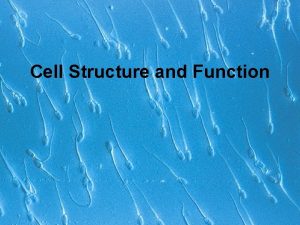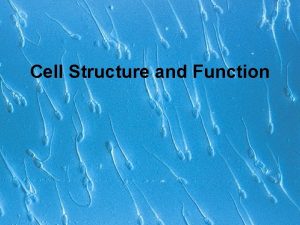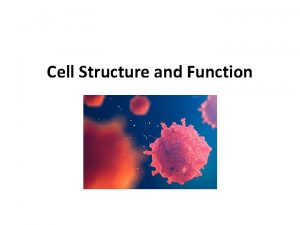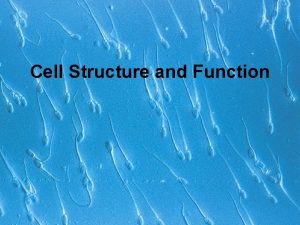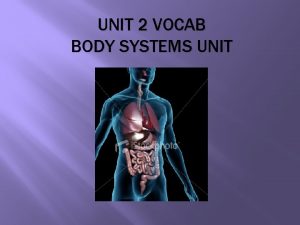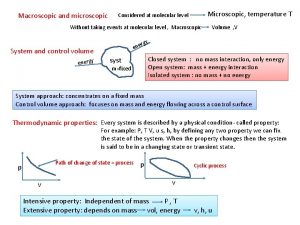Cells Smallest living unit Most are microscopic Principles































- Slides: 31

Cells • Smallest living unit • Most are microscopic

Principles of Cell Theory • All living things are made of cells • Smallest living unit of structure and function of all organisms is the cell • All cells arise from preexisting cells (this principle discarded the idea of spontaneous generation)

Cell Size

Characteristics of All Cells • • A surrounding membrane Protoplasm – cell contents in thick fluid Organelles – structures for cell function Control center with DNA

CELL TYPES 1. Prokaryotic Cells • First cell type on earth • Cell type of Bacteria and Archaea

Prokaryotic Cells • No membrane bound nucleus • Nucleoid = region of DNA concentration • Organelles not bound by membranes

2. Eukaryotic Cells • Nucleus bound by membrane • Include fungi, protists, plant, and animal cells • Possess many organelles Protozoan

Cell Organelles © J Beauchemin 2006

Cell Organelles Organelle= “little organ” Found only inside eukaryotic cells All the stuff in between the organelles is cytosol Everything in a cell except the nucleus is cytoplasm

Cell Membrane Boundary of the cell Made of a phospholipid bilayer

Plasma Membrane • Contains cell contents • Double layer of phospholipids & proteins

Phospholipids • Polar – Hydrophylic head – Hydrophobic tail • Interacts with water

Movement Across the Plasma Membrane • A few molecules move freely – Water, Carbon dioxide, Ammonia, Oxygen • Carrier proteins transport some molecules – Proteins embedded in lipid bilayer – Fluid mosaic model – describes fluid nature of a lipid bilayer with proteins


Nucleus Control center of the cell Contains: Chromosomes (DNA, Protiens. Chromatin) n & Nucleolus Surrounded by a double membrane Usually one per cell

Nucleolus • Most cells have 2 or more • Directs synthesis of RNA • Forms ribosomes

Endoplasmic Reticulum A. k. a. “ER” Connected to nuclear membrane Highway of the cell Rough ER: studied with ribosomes; it makes proteins Smooth ER: no ribosomes; it makes lipids

Rough Endoplasmic Reticulum • Ribosomes attached to surface – Manufacture protiens – Not all ribosomes attached to rough ER • May modify proteins from ribosomes

Smooth Endoplasmic Reticulum • No attached ribosomes • Has enzymes that help build molecules – Carbohydrates – Lipids

Ribosome Site of protein synthesis Found attached to rough ER or floating free in cytosol Produced in a part of the nucleus called the nucleolus That looks familiar…what is a polypeptide?

Golgi Apparatus Looks like a stack of plates Function: Stores, modifies and packages proteins Molecules transported to and from the Golgi by means of vesicles


Lysosomes Garbage disposal of the cell Contain digestive enzymes that break down wastes Which organelles do lysosomes work with?

Mitochondria “Powerhouse of the cell” Cellular respiration Break down fuel molecules (Glucose; Fatty acids) occurs here to release energy(ATP) for the cell to use Bound by a double membrane Has its own strand of DNA

Chloroplast Found only in plant cells Contains the green pigment chlorophyll Site of food (glucose) production Bound by a double membrane

Cell Wall Found in plant and bacterial cells Rigid, protective barrier Located outside of the cell membrane Made of cellulose (fiber)

Vacuoles Large central vacuole usually in plant cells Many smaller vacuoles in animal cells Storage container for water, food, enzymes, wastes, pigments, etc. ' What type of microscope may have been used to take this picture?

Centriole Aids in cell division Usually found only in animal cells Made of microtubules Where else have we talked about microtubules?

Quick Review Which organelle is the control center of the cell? Nucleus Which organelle holds the cell together? Cell membrane Which organelles are not found in animal cells? Cell wall, central vacuole, chloroplasts Which organelle helps plant cells make food? Chloroplasts What does E. R. stand for? Endoplasmic reticulum

Review of Eukaryotic Cells

Review of Eukaryotic Cells
 Smallest living unit
Smallest living unit Mikael ferm
Mikael ferm What is the smallest unit of life
What is the smallest unit of life Cells are the smallest unit of life
Cells are the smallest unit of life Cells are the smallest unit of life
Cells are the smallest unit of life What is the smallest unit of a living organism
What is the smallest unit of a living organism Smallest living unit
Smallest living unit What is the smallest living unit in the body
What is the smallest living unit in the body What is the smallest living unit
What is the smallest living unit Smallest living unit
Smallest living unit What is the smallest unit of a living organism
What is the smallest unit of a living organism What is the smallest unit of living organisms
What is the smallest unit of living organisms Smallest cells
Smallest cells Paranasal sinuses development
Paranasal sinuses development Tubular secretion
Tubular secretion Parafollicular
Parafollicular Somatic vs gamete
Somatic vs gamete Somatic cells vs germ cells
Somatic cells vs germ cells Red blood cells and white blood cells difference
Red blood cells and white blood cells difference Prokaryotic cell vs eukaryotic
Prokaryotic cell vs eukaryotic Plant and animal cells venn diagram
Plant and animal cells venn diagram Prokaryotic cell
Prokaryotic cell The organelle trail
The organelle trail Masses of cells form and steal nutrients from healthy cells
Masses of cells form and steal nutrients from healthy cells Pseudostratified vs simple columnar
Pseudostratified vs simple columnar What animals have prokaryotic cells
What animals have prokaryotic cells Is a staphylococcus cell prokaryotic or eukaryotic
Is a staphylococcus cell prokaryotic or eukaryotic Nondisjunction in meiosis
Nondisjunction in meiosis Cells and life lesson 1 answer key
Cells and life lesson 1 answer key Enzymes speed up chemical reactions by ____
Enzymes speed up chemical reactions by ____ Cells are the building blocks of all living things
Cells are the building blocks of all living things Are chromosomes living or nonliving
Are chromosomes living or nonliving


